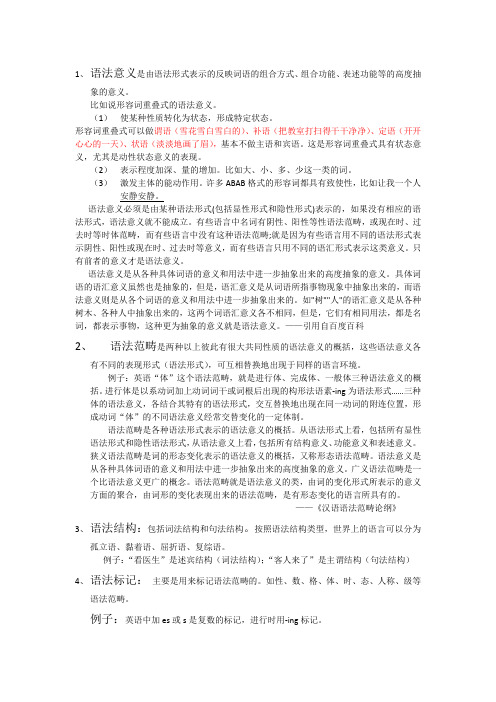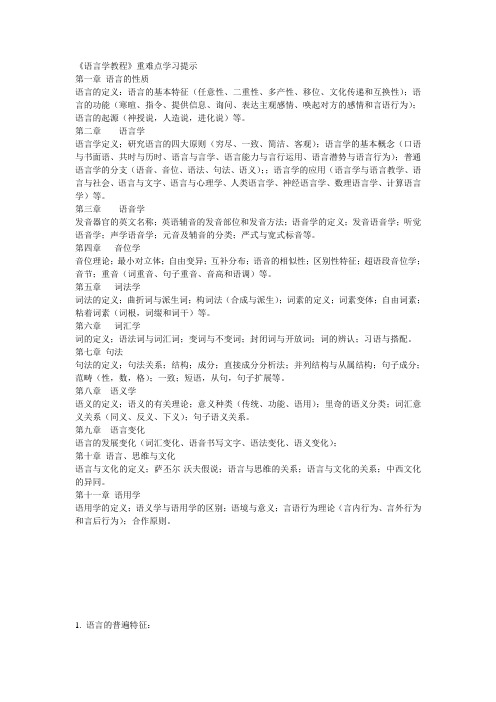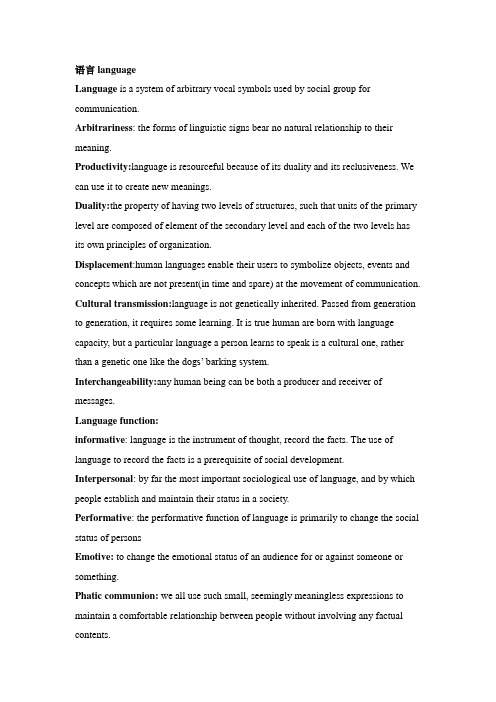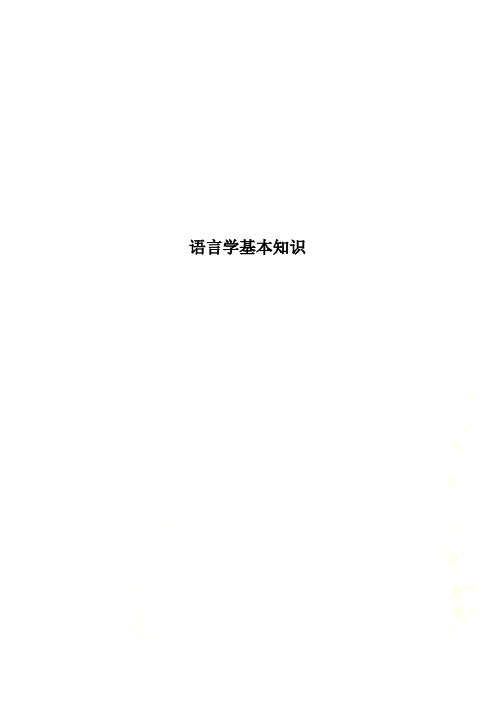(完整版)语言学基本定义
现代语言学

音系学
(四)英语语音的分类 英语中的语音根据气流的受阻情况分为元 音和辅音。气流没有受到任何阻碍所发出 的音是元音;气流在口腔里受到不同方式 的阻碍所发出的音是辅音。 • 英语辅音的分类 • 根据发音方式,英语的辅音可以分为: • 1) 爆破音:发爆破音时,气流开始完全受 阻,然后突然释放,如[p],[b],[t],[d],[k],[g]
语言学研究范畴
音系学 形态学
语用学
句法学
语义学
语言学基本概念
规定性 • 传统语法是规定性的,它 主要建立在笔头语言基础 之上,旨在规定一系列的 语法规则,并且把这些语 法规则强加给语言使用者 。一切符合规定规则的被 认为是“正确的”,否则 就被冠为“错误的”。 描述性 • 语言学研究是描述性的, 不是规定性的。这是语言 学和传统语法的一个重要 区别。语言学研究的目的 是对人们使用的语言进行 客观描述与分析,而不是 对语言的使用作出规定。
5) 文化传递性:
音系学
• (一)语音学 • 什么是语音学 语音学研究的对象是语言的声音媒介, 即 人类语言中使用的全部语音。 语音学有三个分支:发声语音学、听觉语 音学和声学语音学。
音系学
• (二)发音器官 人类的发音器官存在于 咽腔、口腔和鼻腔腔内。 • (三)音标——宽式和严式标音法 音标是 在国际上被广为接受的一套对语音进行标 音的标准符号体系。标音分为宽式和严式 标音法。宽式标音法是用一个符号来表示 一个语音的标音方式。严式标音法是一种 使用变音符号的标音方式,旨在记录同一 个音在不同的语音环境下所发生的细微的 变化
• 根据发音部位,英语辅音可以分为:
• • • • 1) 双唇音:气流受阻部位在双唇,如[p],[b],[m],[w] 2) 唇齿音:下唇与上齿接触使气流受阻,如[f],[v] 3) 齿音:舌尖与上齿接触使气流受阻,如:[θ],[ T] 4) 齿龈音:舌尖与上齿龈隆骨接触使气流受阻,如 :[t],[d],[s],[z],[n],[l],[r] • 5) 腭音:受阻部位发生在舌根与硬腭之间,如:[∫], [ V],[ t∫ ], [dV ], [j] • 6) 软腭音:舌根与软腭接触使气流受阻,如: [k], [g], [ N ] • 7) 喉音:声带短时接触使气流受阻,如:[h]
《语言学基本概念》教案

《语言学基本概念》教案语言学基本概念教案(完整版)
一、引言
- 介绍语言学的定义和重要性
- 提出研究语言学的目标和意义
二、语言学的研究对象和范畴
- 解释语言学的研究对象和范畴
- 探讨语言学的相关分支学科和研究领域
三、语言单位:音素、词素和句素
- 解释语言单位的概念和作用
- 介绍音素、词素和句素的定义和特点
四、语音学基本概念
- 介绍语音学的定义和研究内容
- 解释语音、音标、音位和音系的概念
五、词汇学基本概念
- 介绍词汇学的定义和研究内容
- 解释词、词义和词汇关系的概念
六、语法学基本概念
- 介绍语法学的定义和研究内容
- 解释句子、句型和短语的概念
七、语义学基本概念
- 介绍语义学的定义和研究内容
- 解释词义、句义和篇章意义的概念
八、语用学基本概念
- 介绍语用学的定义和研究内容
- 解释语用规则、会话合作和语用失误的概念
九、语言学研究方法
- 探讨语言学的研究方法和技术
- 介绍语料库语言学和实验语言学的概念
十、总结和复
- 综合回顾语言学的基本概念和重要内容
- 提供复材料和研究资源
十一、题和讨论
- 设计一些题和讨论问题,以检验学生对所学概念的理解和运用能力
十二、参考资料
- 罗伯特·伦德基等著,《现代语言学教程》
- 斯蒂芬·克里·布朗,阿尼塔·艾尔,劳里·英迪斯,《语言学入门》
- ...。
语言学名词解释

(一)名词解释1. 语言学: 语言学是以人类语言作为研究对象的学科, 研究人类语言的性质、结构、发展及其在社会生活中的运用以及语言研究成果的应用问题, 等等。
分理论语言学和应用语言学两个领域。
2. “小学”: 在中国古代, 小学先从教授字的形(六书)、音、义开始, 就把研究文字、训诂、音韵方面的学问统称为小学。
小学一直是经学的一部分, 包括音韵学、训诂学、文字学三个分支学科。
3.非语言交际工具或副语言交际工具: 人们在运用语言进行交际的时候, 不但动嘴, 而且脸部的表情、手的动作、乃至整个躯体的姿态等非语言的东西也都参加进来。
我们这些非语言的交际工具称为副语言交际工具。
副语言交际工具的使用范围非常有限, 只能起辅助性的交际作用, 以补充语言交际的某些不足。
4.辅助性交际工具: 指的文字、旗语、电报代码等在语言的基础上产生的交际工具。
这些交际工具若离开语言就不能独立存在。
其特点是: 都有特殊的服务领域, 使用的范围相当狭窄。
5.符号:符号, 就是指代某种事物的标记, 记号, 它是由一个社会的全体成员共同约定用来表示某种意义的标记和记号。
6.符号的任意性:任意性是语言符号的本质特征之一。
其含义是:语言符号的音义联系并非是本质的, 必然的, 而是由社会成员共同约定的, 一种意义为什么要用这个声音形式, 而不用那种声音形式, 这中间没有什么道理可言, 完全是偶然的、任意的。
语言符号和客观事物之间也没有必然联系。
7.语言符号: 特定语言系统中作为音义结合体的语言单位称为语言符号。
与一般符号相比, 语言符号的主要特点是: 音义结合的任意性、能指的线性特征、所指组合的层次性等等。
8.语言的层级体系: 语言的层级体系: 语言的底层是一套音位, 一种语言的音位的数目虽然只有几十个, 却能构成数目众多的组合。
这些组合为语言符号准备了形式的部分。
语言的上层是音义结合的符号和符号的序列, 这一层又分为若干级。
第一级是语素, 意义在这里被装进形式的口袋, 成了音义结合的最小的符号。
自考汉语言文学语言学概论复习重点考点

自考汉语言文学语言学概论复习重点考点
一、语言学的基本概念
1.语言学的定义:语言学是研究语言的科学。
2.语言学的分类:一般语言学、历史语言学、实用语言学等。
3.语言学研究的内容:语音学、语法学、词汇学、语义学、语用学等。
二、语音学
1.国际音标:常用国际音标及其音值。
2.语音的分类:元音、辅音等。
3.语音的产生:空气流动、声带振动等。
三、语法学
1.句子成分:主语、谓语、宾语等。
2.句子结构:简单句、复合句等。
3.短语的分类:名词短语、动词短语、形容词短语等。
四、词汇学
1.词的定义:具有独立意义的语言单位。
2.词的分类:实词、虚词等。
3.词的构词法:前缀、后缀等。
五、语义学
1.意义的概念:语言单位所表示的概念。
2.意义的分类:词义、句义、上下文义等。
3.意义的变化:词义的扩大和缩小等。
六、语用学
1.语用学的概念:研究语言实际使用情况的学科。
2.语用学的要素:语言行为、语用规则等。
3.语用失误:歧义、言外之意等。
七、其他
1.汉语言文字的演变:甲骨文、小篆、楷书等。
2.语言与社会文化的关系:语言的社会属性、语言的地位等。
3.语言变异现象:方言、行话、新词等。
以上是自考汉语言文学语言学概论的复习重点和考点,希望能对您的复习有所帮助。
(完整word版)语言学概论

第一章语言和语言学。
语言的性质:符号性(符号的任意性、稳固性、渐变性、线条性)、系统性、社会性。
还有民族性、生成性、模糊性。
广义语言:包括语言系统、言语活动和言语作品。
狭义语言:只指语言系统,而言语包括言语活动和言语作品。
语言与言语关系:语言是抽象的,言语是具体的;语言是社会的,言语是个人的;语言是现成的,言语是临时的;语言是有限的,言语是无限的;语言是稳定的,言语是多变的。
语言来自言语,依存于言语;语言制约着言语,指导人进行言语活动。
语言的层级:上层包括语素、词、句子,下层是语音层,包括音位、音节。
语素:最小的语音语义结合体。
词:最小的能够独立运用的语言单位。
句子:最小的语言交际单位。
语言系统的四个子系统:语音、语义、语汇、语法。
语音的系统性主要体现在音位之间的对立和音节内部的组合。
语义的系统性主要表现在义项的聚合关系和句义的组合规则。
语汇系统包括三级语汇单位:语素、词、固定短语。
语素是最基本的语言符号,词和固定短语一般是复合符号,词是语汇系统的主体。
固定短语包括熟语和专名。
语法系统包括词语的结构和功能。
语言的基本关系:组合关系和聚合关系。
组合关系:若干较小的语言单位组合成较大的语言单位,构成成分之间的关系就是组合关系,也叫线性序列关系。
组合关系就是结构关系,有相同组合关系的语言单位构成的类叫结构类。
聚合关系:具有相同组合功能的语言单位之间的关系就是聚合关系,又叫联想关系。
具有相同聚合关系的语言单位就构成某种聚合类即功能类。
语言的词法类型:词根语、屈折语、粘着语、编插语。
词根语又叫孤立语,缺乏形态变化,语法意义主要靠词序和虚词表示。
如汉语。
屈折语通过各种屈折方式表示语法意义,屈折分为内部屈折和外部屈折。
内部屈折通过词的语音交替(改变部分语音)构成不同的语法形式,外部屈折通过词缀表意。
印欧语系、阿拉伯语,尤其俄语和德语。
粘着语又称胶着语,通过加词缀表语法意义。
如土耳其语、日本、朝鲜、蒙古等语。
粘着语与屈折语:都有丰富的形态变化,但粘着语没有内部屈折;粘着语的一个词缀只表示一种语法意义,一种语法意义也只用一个词缀,要表不同意义就加多个词缀;粘着语词缀一般自成音节且词根与词缀和词缀与词缀结合不紧密,独立性相当大。
语言学概论(完整版)ppt课件

针对不同类型的语言障碍和失语症患者,需要采用不同的评估方法和矫治措施,如构音评估、言语流畅度评 估、听力评估等,以及相应的语音训练、言语治疗、听力补偿等手段。
THANKS
感谢观看
语音学定义
研究人类语言声音的科学,包括语音 的产生、传播、感知和变强和音长,它们在语 音中的表现和作用。
语音单位
音素、音节、音步等,以及它们之间 的关系和组合规律。
音系学理论与方法
音系学定义
研究语言声音系统的科学,探讨 语音单位的分类、组合和变化规
则。
音位理论
研究音位及其变体、音位组合和音 位配列等,揭示语音系统的本质和 规律。
语境是指语言使用时所处的环境,包括语言上下文、情景语境和 文化语境等。
语境对词义影响
同一词语在不同语境中可能有不同意义,语境可以帮助确定词语的 具体意义。
语境对句子理解影响
句子的理解需要依赖语境,语境可以提供句子中省略或隐含的信息, 帮助听话人或读者正确理解句子意义。
05
历史比较语言学与类型学
历史比较语言学原理和方法
语用学理论与方法
语用学定义及研究范围
语用学研究语言使用中的语境意义、言外之意和话语理解等问题。
指示语与话语理解
指示语是指代性词语,其意义依赖于语境,话语理解则需要考虑指 示语的语境意义。
会话含义与合作原则
会话含义是指说话人通过话语所传达的隐含意义,合作原则是会话 中双方共同遵循的使会话得以顺利进行的原则。
语言障碍和失语症患者研究
语言障碍的类型和表现
语言障碍包括构音障碍、言语流畅度障碍、听力障碍、阅读理解障碍等不同类型的障碍,表现为发音不清、 口吃、听力损失、阅读困难等症状。
语言学简介课件

重要的实用价值。
语言学研究的未来趋势与挑战
未来趋势
随着科技的发展,语言学与计算机科学 的交叉学科研究将更加深入,如自然语 言处理、机器翻译等。同时,语言学研 究将更加注重跨文化比较和语言接触研 究。
VS
挑战
语言学研究面临着许多挑战,如语言的多 样性和变化性、语言的认知过程和交际功 能等。未来语言学研究需要不断探索和创 新,以解决这些问题。
克里奥尔语
克里奥尔语是指在多语言环境下形成的混合语言,通常在特定社区 中使用,如印度尼西亚的克里奥尔英语。
04
语言学的研究应用
人类学:文化交流与民族认同
01
02
03
语言与文化关系
探讨语言如何反映一个民 族的文化特征,以及语言 在文化传承和交流中的角 色。
语言的多样性
研究不同民族语言之间的 交流障碍和文化误解,以 及如何通过跨文化交流来 克服这些问题。
语言的特点
语言具有系统性、任意性、社会 性和传承性。
语言学的定义与研究对象
语言学的定义
语言学是研究语言的学科,包括语言 的性质、结构、变化和发展等。
语言学的研究对象
语言学的研究对象是语言的各个方面 ,如语音、语法、词汇、语义等。
语言学的发展历程与分支学科
语言学的发展历程
语言学经历了古代语言学、中世纪语言学、现代语言学等不同的发展阶段。
乔姆斯基
转换生成语法的创始人,关注语言的生成性和句法结构。
韩礼德
系统功能语法的奠基人,关注语言的社会功能和意义系统。
中国古代语言学家及其著作
许慎
东汉时期的文字学家和语言学家,著有《说 文解字》,系统阐述汉字的音、形、义及其 演变。
其他古代语言学家及其著 作
【全文】语言学概论-(完整版)-PPT

大家好
17
二、为什么说语言是人类社会最 重要的交际工具?
语言之外,人类还运用其他的交际工具,如: 文字、旗语、灯语、数字、电码、手势、动作、 表情等 。但这些交际工具的作用远远不及语言。
3.作为思想的表现形式→与文学、文化学 关系密切(英汉比较:称谓→年龄、血 缘)
大家好
15
六、语言学的功用
1.提高文化水平,掌握科学技术的基础:研究 本族语的结构规律→指导语文教学实践
2.指导我们学习语言、运用语言和研究语言: 方言、本族语和外语
3.有利于各项语文政策的制定和推行:扫除文 盲、汉字改革、推广普通话、语言规范化
(1)社会语言学:结合社会学和语言学,把语言结 构和运用的各方面与社会环境结合。
(2)心理语言学:重点观察语言与个人的关系,通 过语言了解人的心理认知活动;研究人类大脑的语言 机制,人类怎样运用语言;研究儿童语言习得、语言 得接受和发生过程、语法的心理实现。
(3)神经语言学:研究语言和大脑结构的关系,通 过神经控制系统研究言语的产生;中心问题是大脑如 何生成语言。 (4)统计语言学;数理语言学;实验语音学;计算 语言学;语言病理学。
大家好
7
三个主要的结构主义学派:
(1)布拉格学派(结构—功能学派):1926年成 立学会,强调语言是一个功能体系,认为句子能 从语法角度分析,也能从功能角度分析,用主位 和述位来分析句子。代表人物及著作:马泰修斯 《捷克语与普通语言学》、雅科布逊《论俄语音
系的演变》《儿童语言,失语症与语音共性》。
解释语言学常用定义

1、语法意义是由语法形式表示的反映词语的组合方式、组合功能、表述功能等的高度抽象的意义。
比如说形容词重叠式的语法意义。
(1)使某种性质转化为状态,形成特定状态。
形容词重叠式可以做谓语(雪花雪白雪白的)、补语(把教室打扫得干干净净)、定语(开开心心的一天)、状语(淡淡地画了眉),基本不做主语和宾语。
这是形容词重叠式具有状态意义,尤其是动性状态意义的表现。
(2)表示程度加深、量的增加。
比如大、小、多、少这一类的词。
(3)激发主体的能动作用。
许多ABAB格式的形容词都具有致使性,比如让我一个人安静安静。
语法意义必须是由某种语法形式(包括显性形式和隐性形式)表示的,如果没有相应的语法形式,语法意义就不能成立。
有些语言中名词有阴性、阳性等性语法范畴,或现在时、过去时等时体范畴,而有些语言中没有这种语法范畴;就是因为有些语言用不同的语法形式表示阴性、阳性或现在时、过去时等意义,而有些语言只用不同的语汇形式表示这类意义。
只有前者的意义才是语法意义。
语法意义是从各种具体词语的意义和用法中进一步抽象出来的高度抽象的意义。
具体词语的语汇意义虽然也是抽象的,但是,语汇意义是从词语所指事物现象中抽象出来的,而语法意义则是从各个词语的意义和用法中进一步抽象出来的。
如"树""人"的语汇意义是从各种树木、各种人中抽象出来的,这两个词语汇意义各不相同,但是,它们有相同用法,都是名词,都表示事物,这种更为抽象的意义就是语法意义。
——引用自百度百科2、语法范畴是两种以上彼此有很大共同性质的语法意义的概括,这些语法意义各有不同的表现形式(语法形式),可互相替换地出现于同样的语言环境。
例子:英语“体”这个语法范畴,就是进行体、完成体、一般体三种语法意义的概括。
进行体是以系动词加上动词词干或词根后出现的构形法语素-ing为语法形式……三种体的语法意义,各结合其特有的语法形式,交互替换地出现在同一动词的附连位置,形成动词“体”的不同语法意义经常交替变化的一定体制。
语言学基本概念

语言学(linguistics)是以人类语言为研究对象的学科,探索范围包括语言的性质、功能、结构、运用和历史发展,以及其他与语言有关的问题。
语言学研究的对象是客观存在的语言事实。
不管是现代的语言还是古代的语言,都是客观存在的语言现象。
尽管不同话语表达的意义是带有主观性的和千差万别的,但是传递出来的语言信息却是能被别人共同理解的,语言学被普遍定义为对语言的一种科学化、系统化的理论研究。
并且语言是人类最重要的交际工具,是思想的直接现实。
语言学概论完整版电子课件

词汇的构成
包括单纯词和合成词两大类。单 纯词是由一个语素构成的词,合 成词是由两个或两个以上语素构 成的词。
词汇的分类
根据词汇的构成特点和使用频率 ,可以将词汇分为基本词汇和一 般词汇两大类。基本词汇是语言 中最稳定、最核心的部分,一般 词汇则是语言中变化较快、较为 活跃的部分。
词汇的聚合
根据词汇之间的语义关系,可以 将词汇聚合为不同的语义场,如 动物语义场、植物语义场等。
THANK YOU
语言的交际功能与文化载体作用
语言是人类最重要的交际工具之一,同时也是文化的载体,反映了人 类社会的历史、文化、习俗等。
当前存在问题和挑战
语言多样性与语言濒危
全球范围内存在着大量的语言,但很 多语言面临着濒危的境地,需要采取 措施加以保护。
语言教育与学习难度
语言教育和学习需要投入大量的时间 和精力,而且学习难度因人而异,需 要针对不同人群采取不同的教学方法 和策略。
思维
语言是思维的主要工具,心理过程影响语言表达和理解的方式。
认知策略在语言运用中作用
概念化
人们运用认知策略将经验概念化,形成语言 中的词汇和概念。
范畴化
认知策略帮助人们将事物归类和范畴化,形 成语言中的语法和语义范畴。
隐喻和转喻
认知策略通过隐喻和转喻等方式扩展语言表 达式,丰富语言内涵。
心理语言学相关理论
词义的模糊性
词义具有一定的模糊性,即词义界限 的不明确性。这种模糊性是由于语言 符号的有限性和客观世界的无限性之 间的矛盾所导致的。
04
句法结构与分析方法
句法结构概述及研究内容
句法结构的定义
句法结构指的是句子中词语之间的结构关系,包括词 语的排列顺序、层次结构和语义关系等。
语言学纲要重要知识点

语言学纲要重要知识点一、知识概述《语言学纲要重要知识点》①基本定义:语言学纲要涵盖了语音、词汇、语法、语义等语言相关要素的基本原理和规律的知识,就像是一本语言的说明书,把语言这台机器是怎么运转的原理给你讲清楚。
例如语音里元音和辅音的区别,元音是发音时声带振动呼出的气流通过口腔时不受阻碍发出的音,像/a/,发这个音的时候气流很顺畅。
辅音呢,是受到阻碍发出的音,像/b/,发音时双唇先紧闭阻碍气流,然后再放开。
②重要程度:在语言学学科里,它处于基础和核心的地位。
就好比是盖房子的地基,要是这个没弄好,想深入学习其他语言学分支就很困难。
不管是研究某种具体语言,还是进行语言教学等工作,都要先掌握语言的基本规则,这就离不开语言学纲要里的知识点。
③前置知识:其实不需要太深的前置知识,只要有正常的语言使用经验就行,就像咱们平时说话交流,对语言有个基本的感知就好。
比如你得知道怎么表达自己的想法,最基本句子是怎么组成的。
④应用价值:在语言教学方面,可以帮助教师更好地制定教学计划、解释语法现象等。
我们去学一门外语,这些知识就能让我们更容易理解外语的规则。
如果有一天你要研究方言的演变,也得从这些基本的语言学知识开始。
比如说你发现某个方言里某个词的发音变了,那你得先明白语音的那些基本原理才能知道为什么会变。
二、知识体系①知识图谱:语言学纲要的知识点是一个相互联系的整体。
语音是基础,词汇是语音和语法联系的桥梁,语法又构建着句子的框架,语义给这个框架填充内容。
它们就像一个生态系统,每个部分都不能缺少,缺了哪个环节整个语言体系就不完整了。
②关联知识:它和许多其他的语言学知识都有关联。
与语音学、句法学、语义学等知识相互交织。
比如句法学里句子结构的分析就离不开对语法规则的基本理解,而这部分就是语言学纲要里的重要内容。
就像接力赛,每个学科是一棒,相互传递才能完成整个对语言研究的马拉松。
③重难点分析:- 掌握难度:说真的,语法部分有些难搞。
(完整版)胡壮麟语言学教程笔记、重点全解

《语言学教程》重难点学习提示第一章语言的性质语言的定义:语言的基本特征(任意性、二重性、多产性、移位、文化传递和互换性);语言的功能(寒暄、指令、提供信息、询问、表达主观感情、唤起对方的感情和言语行为);语言的起源(神授说,人造说,进化说)等。
第二章语言学语言学定义;研究语言的四大原则(穷尽、一致、简洁、客观);语言学的基本概念(口语与书面语、共时与历时、语言与言学、语言能力与言行运用、语言潜势与语言行为);普通语言学的分支(语音、音位、语法、句法、语义);;语言学的应用(语言学与语言教学、语言与社会、语言与文字、语言与心理学、人类语言学、神经语言学、数理语言学、计算语言学)等。
第三章语音学发音器官的英文名称;英语辅音的发音部位和发音方法;语音学的定义;发音语音学;听觉语音学;声学语音学;元音及辅音的分类;严式与宽式标音等。
第四章音位学音位理论;最小对立体;自由变异;互补分布;语音的相似性;区别性特征;超语段音位学;音节;重音(词重音、句子重音、音高和语调)等。
第五章词法学词法的定义;曲折词与派生词;构词法(合成与派生);词素的定义;词素变体;自由词素;粘着词素(词根,词缀和词干)等。
第六章词汇学词的定义;语法词与词汇词;变词与不变词;封闭词与开放词;词的辨认;习语与搭配。
第七章句法句法的定义;句法关系;结构;成分;直接成分分析法;并列结构与从属结构;句子成分;范畴(性,数,格);一致;短语,从句,句子扩展等。
第八章语义学语义的定义;语义的有关理论;意义种类(传统、功能、语用);里奇的语义分类;词汇意义关系(同义、反义、下义);句子语义关系。
第九章语言变化语言的发展变化(词汇变化、语音书写文字、语法变化、语义变化);第十章语言、思维与文化语言与文化的定义;萨丕尔-沃夫假说;语言与思维的关系;语言与文化的关系;中西文化的异同。
第十一章语用学语用学的定义;语义学与语用学的区别;语境与意义;言语行为理论(言内行为、言外行为和言后行为);合作原则。
(完整版)语言学基本定义

语言languageLanguage is a system of arbitrary vocal symbols used by social group for communication.Arbitrariness: the forms of linguistic signs bear no natural relationship to their meaning.Productivity:language is resourceful because of its duality and its reclusiveness. We can use it to create new meanings.Duality:the property of having two levels of structures, such that units of the primary level are composed of element of the secondary level and each of the two levels has its own principles of organization.Displacement:human languages enable their users to symbolize objects, events and concepts which are not present(in time and spare) at the movement of communication. Cultural transmission:language is not genetically inherited. Passed from generation to generation, it requires some learning. It is true human are born with language capacity, but a particular language a person learns to speak is a cultural one, rather than a genetic one like the dogs’ barking system.Interchangeability:any human being can be both a producer and receiver of messages.Language function:informative: language is the instrument of thought, record the facts. The use of language to record the facts is a prerequisite of social development. Interpersonal: by far the most important sociological use of language, and by which people establish and maintain their status in a society.Performative: the performative function of language is primarily to change the social status of personsEmotive: to change the emotional status of an audience for or against someone or something.Phatic communion: we all use such small, seemingly meaningless expressions to maintain a comfortable relationship between people without involving any factual contents.Recreational: the recreational function of a language is often overlooked because it seems so restrictive in purpose and supposedly so limited in usefulness. Metalingual: our language can be used to talk about itself.Sociolinguistics—the study of language with reference to society. Psycholinguistics---the study of language with reference to the working of the mind. Applied linguistics---the application of linguistic principles and theories to language teaching and learning.Important distinctions in linguistics: 规定性Prescriptive .描述性Descriptive /8.共时语言学Synchronical linguistics 7.历时语言学Diachronic linguistics /5.语言能力Competence 6.语言运用performance /9.语言langue 10.言语parole /speech, writing/ traditional grammar and modern linguistics第二章音系学1 Phonologyis the study of the sound patterns and sound systems of languages. It aims to discover the principles that govern the way sounds are organized in languages, and to explain the variations that occur.2 international phonetic alphabetA set of standard phonetic symbols in the form of a chart, designed by the international phonetic association since 1888. It has been revised from time to time to include new discoveries and changes in phonetic theory and practice.3 consonants and vowelsConsonant are produced by a closure in the vocal tract, or by a narrowing, which is so marked that air can not escape without producing audible friction.V owel is produced without such stricture so that air escapes in a relatively unimpeded way through the mouth or nose.4 cardinal vowelAre a set of vowel qualities arbitrarily defined, fixed and unchanging, intended to provide a frame of reference for the description of the actual vowels of existing language.5 anticipatory and perseverative co-articulationwhen such simultaneous or overlapping articulation are involved, we call the process co-articulation.If the sound becomes more like the following sound, it is known as anticipatoryco-articulation. If the sound shows the influence of the proceeding sound,it is perseverative co-articulation.6PhonemeThe smallest of sound which can distinguish two words7AllophonesDifferent phones which can represent a phoneme in different environments are called the allophones of that phoneme.8Minimal pairAre two words in a language which differ from each other by only one distinctive sound and which also differ in meaning.9free variationif two sounds occurring in the same environment do not contrast, that is the substitution of one for the other does not produce a different word form, but merely a different pronunciation of the same word, then the two words are in free variation. Chapter three 词汇学The total number of words stored in the brain is called the lexicon.Words are the smallest free units of language that unite sounds with meaning.Word :A unit of expression that has universal intuitive recognition by native speakers, whether it is expressed in spoken or written form.Lexeme: the abstract unit underlying the smallest unit in the lexical system of a language, which appears in different grammatical contexts.Grammatical/Functional words: express grammatical meanings, such as conjunctions, prepositions, articles, pronouns.Lexical/content words: have lexical meanings, those which refer to substance, action and quality, such as nouns, verbs, adjectives, and adverbs.Open-class words: a word group whose membership is in principle in finite or unlimited. New members can be added.Closed-class words: a word group whose membership is fixed or limited, new members are not regularly added.Morphology; the study of word formation, the internal structure of words, and the rules by which words are formed.Morphemes: the smallest unit language in terms of relationship between expression and content, a unit that cannot be further divided into smaller units without destroying or drastically altering the meaning, whether it is lexical or grammatical.Free morphemes: those that may constitute words by themselves.Bound morphemes;those that can not occur aloneRoot: the base form of a word that cannot be further analyzed without total loss of identity. It is that part of a word-form that remains when all the inflectional affixes and derivational affixes have been removed.Affix: the types of formative/morpheme that can be used only when added to another morpheme.Base: any form to which affixes of any kind can be added; a form to which a rule of word formation is applied.Stem: the part of the word form which remains when all inflectional affixes have been removed.Inflection: indicates grammatical relations by adding inflectional affixes. Derivation: combination of an existing word and an affix to form a new word. Compounding/composition is word-formation process consisting of joining two or more bases to form a new unit, a compound word-An Introduction to Modern Linguistics.Endocentric: one element serves as the head, of same syntactic class as the whole the relationship of ‘a kind of’.Exocentric: there is no head, no elements is of the same syntactic class as the whole, so not a relationship of ‘a kind of ‘something.Derivation: is also called ‘affixation’. It is the morphological process whereby grammatical of lexical information is added to the base.Conversion: is a word-formation process by which a word is altered from one part of speech to anther without the addition or deletion of any morpheme.Allomorph: some morphemes have a single form in all contexts. But a morpheme may have considerable variations, alternate shapes or phonetic forms called the allomorph.Blending: a process of word-information in which a new word is formed by combining the meanings and sounds of two words, one of which is not in its full form or both of which are not in their full forms.Back-formation: a shorter word is derived by deleting an imagined affix from a longer form already in the language.Acronym: words formed from the initial letters of the name of an organization or scientific term, etc. it differs from initialisms in that they are pronounced as words rather than as sequence of letter.Initialism: a type of shortening, using the first letter of words to form a proper name, a technical term, or phrase; an initialism is pronounced letter by letter.Analogical creation: It can account for the coexistence of two forms, regular and irregular, I the conjugation of some English verbs.Loanwords: both form and meaning are borrowed with only a slight adaptation. Loanblend: part of the form is native and part is borrowed, but the meaning is fully borrowed.Chapter 4 syntaxSyntax: the study of the rules governing the way words are combined to form sentences in a language, or simply the study of the formation of sentences. Category: the term category in some approaches refers to classes and functions in its narrow sense. More specifically, it refers to the defining properties of these general units.Phrase: is a single element of structure containing more than one word, and lacking the subject-predicate structure typical of clause.Word group is an extension of word of a particular class by way of modification with its main features of the class unchanged.Clause: a constituent with its own subjects and predicate when it is included in a lager sentence.Syntagmatic is a relation between one item and others in a sequence or between elements which are all present.Paradigmatic relation refers to classes or sets of words substitutable for each other grammatically in sentences with the same structure.grammatical construction; any syntactic construct which is assigned one or more conventional functions in a language, together with whatever is linguistically conventionalized about its contribution to the meaning or use the construct contains. constituent is a term used in structural sentence analysis for every linguistic unit, which is a part of a larger linguistic unit. Several constituents together form a construction.An endocentric construction is one whose distribution is functionally equivalent to one of its constituents, which serves as the center or head of the whole.Exocentric construction refers to a group of syntactically related words where none of the words is functionally equivalent to the group as a whole, that is, there is no definable “Centre” or “Head” inside the group, usually including the basic sentence, the prepositional phrase, the predicate construction, and the connective construction. Subordinate construction those in which there is only one head, with the head being dominant and the other constituents dependent,Coordinate construction:there are more than one head, the head can stand for the original construction functionally.Deep structure: the abstract representation of the syntactic properties of a constructionSurface structure: the final stage in syntactic derivation of a construction.Chapter five SemanticsDenotation involves the relationship between a linguistic unit and the non-linguistic entities to which it refers. Thus it is equivalent to referential meaning. Connotation-opposite to denotation, means the properties of the entity a word denotes.Sense be defined as the semantics relations between one word and another, or more generally between the one linguistic unit and another.Reference: is concerned with the relation between a word and the thing it refers to , or more generally between a linguistic unit and non-linguistic entity it refers to. Synonymy-refers to the sameness or close similarity of meaningAntonymy-oppositeness of meaning.Complementary antonymy-the denial of one member of the pair implies the assertion of the other.Converse/reversal antonyms/relational opposites-exhibits the reversal of the relationship between the two items, one presupposes the other.Hyponymy上下义-inclusiveness, a relation of inclusion Compositionality-the idea that the meaning of a sentence depends on the meaning of the constitute words and the way they are combined-the principle of compositionality.Polysemy一次多义-the same one word may have more than one meaning. Homonymy同音同形异义-the phenomenon that words having different meaning have the same form.Conceptual meaning-leech defined as the logical, cognitive, or denotative content. In other words, it overlaps to a large extent with the notion of reference.Linguistic semantics-the study of the meaning of linguistic units, words and sentences in particularPropositional logic-it is also know as propositional calculus or sentential calculus, is the study of the truth conditions for propositionsProposition-is expressed by a declarative sentence when that sentence is uttered to make a statement.。
语言学基本知识

语言学基本知识语言学的基本概念1.What is linguistics?(1)The definition: Linguistics is usually defined as the science of language, or,alternatively, the scientific study of language.The main branches of Linguistics: 语音学Phonology 音位学Morphology 形态学Syntax 句法学Semantics 语义学Pragmatics 语用学2.General Linguistics & Applied Linguistics(1)The main differenceGeneral Linguistics: 理论研究,研究对象为人类所有语言Applied Linguistics: 应用研究,语言在各个领域的实际应用(2)The main branches of eachGeneral Linguistics: phonetics, phonology, morphology, syntax,semantics, PragmaticsApplied Linguistics: Sociolinguistics, Psycholinguistics,Physiological Phonelics, etc. (Page 64, Para1) Note: 上述应用语言学分分支,指的是广义的应用语言学的分支,狭义的应用语言学只指语言教学3.Important distinctions in Linguistics(1)Descriptive Linguistics V.S. Prescriptive LinguisticsDon’t say X. a prescriptive commandPeople don’t say X. a descriptive statementThe distinction lies in prescribing how things ought to be and describing how things are.Prescriptive Linguistics: 规定正确的用法,按照此规定使用语言Descriptive Linguistics: 语言的实际用法(2)Synchronic Linguistics V.S. Diachronic Linguistics ----SaussureDiachronic Linguistics: the study of language through the course of its history.Synchronic Linguistics: the study of language, which takes a fixedinstant as its point of observation.(3)Speech V.S. WritingSpeech: communication by word of mouthWriting: symbol of language(4)Langue V.S. ParoleLangue: the common possession of a speech community 言语活动中社会成员共同使用的部分,是社会共有的交际工具。
《语言学纲要》名词解释(完整版)

《语言学纲要》名词解释导言1.语言学:以语言作为研究对象的一门独立科学。
2.专语语言学:又称具体语言学,是指以一种语言为研究对象,探究这一具体语言的规律的语言学门类。
3.普通语言学:以人类一般语言为研究对象,探究人类语言的起源、发展、本质,探究人类语言内部结构的共性,即普遍规律的语言学门类。
4.共时语言学:从语言发展的一个横断面对一种语言在特定时期的相对静止的状态进行静态研究的语言学分支。
5.历时语言学:又叫历时语言学,是从纵向发展的角度研究某种语言从一个时代到另一时代的发展变化的语言学分支。
6.语文学:又叫传统语言学,用于指19世纪历史比较语言学产生之前的语言研究,这时的语言研究尚未独立,语言学作为其他学科的附庸而存在,语言研究的主要目的是为了阅读古籍和语文教学,从而为统治者治理国家,或为其他学科的研究服务。
7.小学:中国传统的语文学,包括分析字形的文字学、研究字音的音韵学、研究字义的训诂学,围绕阐释和解读先秦典籍来展开研究,因此又被人们称为经学的附庸。
形成了以字为中心、音形义的语言研究。
8.理论语言学:以侧重探索语言本身的特点和规律为目的的语言学分支学科。
9. 应用语言学:狭义的应用语言学指语言教学(包括聋哑盲教学)、文字的创制和改革、正音正字、词典编撰等,广义的应用语言学还包括与计算机有关的机器翻译、情报检索、语音识别、自然语言处理等。
10.历史比较语言学:19世纪30年代兴起的一个语言学的重要流派,研究具有共同母语的语言之间的亲属关系以及它们的历史发展。
它的出现是语言学走上独立发展道路的标志,为现代语言学的建立奠定了坚实的基础。
11.结构语言学:又称结构主义语言学,是指20世纪以费尔迪南.德.索绪尔的语言学理论为代表以及受这种理论影响而发展起来的三大语言学派:布拉格学派、哥本哈根学派、美国描写主义语言学派。
12.描写语言学:结构主义语言学注重对话语言的结构共时描写,偏重结构形式的静态研究,不重视意义,重视语言个性,不重视语言的共性,因此又被称为描写语言学。
语言学基本概念

【语言学】语言学是以语言为研究对象的科学。
【“小学”】“小学”是中国传统的语文学,围绕解释和解读先秦典籍来展开研究,从而诞生了分析字形的文字学、研究字音的音韵学、解释字义的训诂学。
因此又被人们称为经学的附庸。
【思维】思维是认识现实世界时的动脑筋的过程,也指动脑筋时进行比较、分析、综合以认识现实的能力。
【符号】符号是由一定的形式构成的表示一定意义的记号或标记,包括形式和意义两个方面,其作用是指称现实现象。
【语言符号】语言符号是由音、义结合构成的,能代表或指称现象。
“音”是语言符号的物质表现形式,“义”是语言符号的内容,只有音和义结合才能指称现实现象,构成语言的符号。
For personal use only in study and research; not for commercial use【征候】征候是事物本质的特征,它代表着事物,可以让我们通过它来推知事物。
【组合规则】构成线性序列的语言成分之间的结构关系,就是说,语言符号的单位互相组合为一个更大单位的规则。
【聚合规则】在同一个结构位置上不同结构单位的替换规则。
【音标】记录音素的标写符号。
【国际音标】国际语音协会指定的一套记音符号,是用来记录各民族语言的语音的。
国际音标符合“一个音素一个符号,一个符号一个音素”的原则。
【音位学】音位学是在了解语音的物理、生理特性的基础上从语言的社会功能的角度对语音的研究。
【音素】音素是人类语言从音质角度划分出来的最小的语音单位。
【清音、浊音】清音、浊音是语音中的发音特点。
辅音的发音体是阻碍气流的发音部位,但有时声带也参与发音。
发音时声带颤动的辅音叫浊辅音,不颤动的叫清辅音。
【音质音位】以音素为材料,从音质的角度分析的音位,叫做音质音位。
【非音质音位】有区别词的语音形式作用的音高、音重、音长叫做非音质音位。
【调位】有区别词的语音形式作用的音高变化,叫做调位。
【重位/势位】能区别词的语音形式的重音叫做重位或势位。
- 1、下载文档前请自行甄别文档内容的完整性,平台不提供额外的编辑、内容补充、找答案等附加服务。
- 2、"仅部分预览"的文档,不可在线预览部分如存在完整性等问题,可反馈申请退款(可完整预览的文档不适用该条件!)。
- 3、如文档侵犯您的权益,请联系客服反馈,我们会尽快为您处理(人工客服工作时间:9:00-18:30)。
语言languageLanguage is a system of arbitrary vocal symbols used by social group for communication.Arbitrariness: the forms of linguistic signs bear no natural relationship to their meaning.Productivity:language is resourceful because of its duality and its reclusiveness. We can use it to create new meanings.Duality:the property of having two levels of structures, such that units of the primary level are composed of element of the secondary level and each of the two levels has its own principles of organization.Displacement:human languages enable their users to symbolize objects, events and concepts which are not present(in time and spare) at the movement of communication. Cultural transmission:language is not genetically inherited. Passed from generation to generation, it requires some learning. It is true human are born with language capacity, but a particular language a person learns to speak is a cultural one, rather than a genetic one like the dogs’ barking system.Interchangeability:any human being can be both a producer and receiver of messages.Language function:informative: language is the instrument of thought, record the facts. The use of language to record the facts is a prerequisite of social development. Interpersonal: by far the most important sociological use of language, and by which people establish and maintain their status in a society.Performative: the performative function of language is primarily to change the social status of personsEmotive: to change the emotional status of an audience for or against someone or something.Phatic communion: we all use such small, seemingly meaningless expressions to maintain a comfortable relationship between people without involving any factual contents.Recreational: the recreational function of a language is often overlooked because it seems so restrictive in purpose and supposedly so limited in usefulness. Metalingual: our language can be used to talk about itself.Sociolinguistics—the study of language with reference to society. Psycholinguistics---the study of language with reference to the working of the mind. Applied linguistics---the application of linguistic principles and theories to language teaching and learning.Important distinctions in linguistics: 规定性Prescriptive .描述性Descriptive /8.共时语言学Synchronical linguistics 7.历时语言学Diachronic linguistics /5.语言能力Competence 6.语言运用performance /9.语言langue 10.言语parole /speech, writing/ traditional grammar and modern linguistics第二章音系学1 Phonologyis the study of the sound patterns and sound systems of languages. It aims to discover the principles that govern the way sounds are organized in languages, and to explain the variations that occur.2 international phonetic alphabetA set of standard phonetic symbols in the form of a chart, designed by the international phonetic association since 1888. It has been revised from time to time to include new discoveries and changes in phonetic theory and practice.3 consonants and vowelsConsonant are produced by a closure in the vocal tract, or by a narrowing, which is so marked that air can not escape without producing audible friction.V owel is produced without such stricture so that air escapes in a relatively unimpeded way through the mouth or nose.4 cardinal vowelAre a set of vowel qualities arbitrarily defined, fixed and unchanging, intended to provide a frame of reference for the description of the actual vowels of existing language.5 anticipatory and perseverative co-articulationwhen such simultaneous or overlapping articulation are involved, we call the process co-articulation.If the sound becomes more like the following sound, it is known as anticipatoryco-articulation. If the sound shows the influence of the proceeding sound,it is perseverative co-articulation.6PhonemeThe smallest of sound which can distinguish two words7AllophonesDifferent phones which can represent a phoneme in different environments are called the allophones of that phoneme.8Minimal pairAre two words in a language which differ from each other by only one distinctive sound and which also differ in meaning.9free variationif two sounds occurring in the same environment do not contrast, that is the substitution of one for the other does not produce a different word form, but merely a different pronunciation of the same word, then the two words are in free variation. Chapter three 词汇学The total number of words stored in the brain is called the lexicon.Words are the smallest free units of language that unite sounds with meaning.Word :A unit of expression that has universal intuitive recognition by native speakers, whether it is expressed in spoken or written form.Lexeme: the abstract unit underlying the smallest unit in the lexical system of a language, which appears in different grammatical contexts.Grammatical/Functional words: express grammatical meanings, such as conjunctions, prepositions, articles, pronouns.Lexical/content words: have lexical meanings, those which refer to substance, action and quality, such as nouns, verbs, adjectives, and adverbs.Open-class words: a word group whose membership is in principle in finite or unlimited. New members can be added.Closed-class words: a word group whose membership is fixed or limited, new members are not regularly added.Morphology; the study of word formation, the internal structure of words, and the rules by which words are formed.Morphemes: the smallest unit language in terms of relationship between expression and content, a unit that cannot be further divided into smaller units without destroying or drastically altering the meaning, whether it is lexical or grammatical.Free morphemes: those that may constitute words by themselves.Bound morphemes;those that can not occur aloneRoot: the base form of a word that cannot be further analyzed without total loss of identity. It is that part of a word-form that remains when all the inflectional affixes and derivational affixes have been removed.Affix: the types of formative/morpheme that can be used only when added to another morpheme.Base: any form to which affixes of any kind can be added; a form to which a rule of word formation is applied.Stem: the part of the word form which remains when all inflectional affixes have been removed.Inflection: indicates grammatical relations by adding inflectional affixes. Derivation: combination of an existing word and an affix to form a new word. Compounding/composition is word-formation process consisting of joining two or more bases to form a new unit, a compound word-An Introduction to Modern Linguistics.Endocentric: one element serves as the head, of same syntactic class as the whole the relationship of ‘a kind of’.Exocentric: there is no head, no elements is of the same syntactic class as the whole, so not a relationship of ‘a kind of ‘something.Derivation: is also called ‘affixation’. It is the morphological process whereby grammatical of lexical information is added to the base.Conversion: is a word-formation process by which a word is altered from one part of speech to anther without the addition or deletion of any morpheme.Allomorph: some morphemes have a single form in all contexts. But a morpheme may have considerable variations, alternate shapes or phonetic forms called the allomorph.Blending: a process of word-information in which a new word is formed by combining the meanings and sounds of two words, one of which is not in its full form or both of which are not in their full forms.Back-formation: a shorter word is derived by deleting an imagined affix from a longer form already in the language.Acronym: words formed from the initial letters of the name of an organization or scientific term, etc. it differs from initialisms in that they are pronounced as words rather than as sequence of letter.Initialism: a type of shortening, using the first letter of words to form a proper name, a technical term, or phrase; an initialism is pronounced letter by letter.Analogical creation: It can account for the coexistence of two forms, regular and irregular, I the conjugation of some English verbs.Loanwords: both form and meaning are borrowed with only a slight adaptation. Loanblend: part of the form is native and part is borrowed, but the meaning is fully borrowed.Chapter 4 syntaxSyntax: the study of the rules governing the way words are combined to form sentences in a language, or simply the study of the formation of sentences. Category: the term category in some approaches refers to classes and functions in its narrow sense. More specifically, it refers to the defining properties of these general units.Phrase: is a single element of structure containing more than one word, and lacking the subject-predicate structure typical of clause.Word group is an extension of word of a particular class by way of modification with its main features of the class unchanged.Clause: a constituent with its own subjects and predicate when it is included in a lager sentence.Syntagmatic is a relation between one item and others in a sequence or between elements which are all present.Paradigmatic relation refers to classes or sets of words substitutable for each other grammatically in sentences with the same structure.grammatical construction; any syntactic construct which is assigned one or more conventional functions in a language, together with whatever is linguistically conventionalized about its contribution to the meaning or use the construct contains. constituent is a term used in structural sentence analysis for every linguistic unit, which is a part of a larger linguistic unit. Several constituents together form a construction.An endocentric construction is one whose distribution is functionally equivalent to one of its constituents, which serves as the center or head of the whole.Exocentric construction refers to a group of syntactically related words where none of the words is functionally equivalent to the group as a whole, that is, there is no definable “Centre” or “Head” inside the group, usually including the basic sentence, the prepositional phrase, the predicate construction, and the connective construction. Subordinate construction those in which there is only one head, with the head being dominant and the other constituents dependent,Coordinate construction:there are more than one head, the head can stand for the original construction functionally.Deep structure: the abstract representation of the syntactic properties of a constructionSurface structure: the final stage in syntactic derivation of a construction.Chapter five SemanticsDenotation involves the relationship between a linguistic unit and the non-linguistic entities to which it refers. Thus it is equivalent to referential meaning. Connotation-opposite to denotation, means the properties of the entity a word denotes.Sense be defined as the semantics relations between one word and another, or more generally between the one linguistic unit and another.Reference: is concerned with the relation between a word and the thing it refers to , or more generally between a linguistic unit and non-linguistic entity it refers to. Synonymy-refers to the sameness or close similarity of meaningAntonymy-oppositeness of meaning.Complementary antonymy-the denial of one member of the pair implies the assertion of the other.Converse/reversal antonyms/relational opposites-exhibits the reversal of the relationship between the two items, one presupposes the other.Hyponymy上下义-inclusiveness, a relation of inclusion Compositionality-the idea that the meaning of a sentence depends on the meaning of the constitute words and the way they are combined-the principle of compositionality.Polysemy一次多义-the same one word may have more than one meaning. Homonymy同音同形异义-the phenomenon that words having different meaning have the same form.Conceptual meaning-leech defined as the logical, cognitive, or denotative content. In other words, it overlaps to a large extent with the notion of reference.Linguistic semantics-the study of the meaning of linguistic units, words and sentences in particularPropositional logic-it is also know as propositional calculus or sentential calculus, is the study of the truth conditions for propositionsProposition-is expressed by a declarative sentence when that sentence is uttered to make a statement.。
